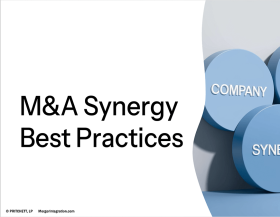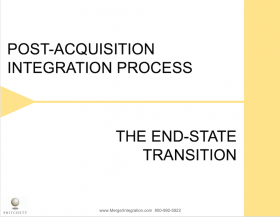M&A Integration Process
Execution Phase
High-level planning defines the future state.
Detailed planning defines the transition.
Execution is when the changes are made.
- Requires clear accountability and project ownership by leaders in the newly defined organization.
- Involves disciplined project management for each major project identified during detailed planning.
- Overall progress managed for key milestones at the executive level.
Key Best Practices
- Establish clear accountability and project ownership by leaders in the newly defined organization.
- Recheck for clear accountability for integration projects including objectives, scope, timeline, expected results, and resources
- Align executive ownership of integration projects with the emerging organization structure
- Align individual performance incentives/bonus programs with planned integration objectives
- Assign resources with strong project management skills to key areas
- Implement an overall program management process to monitor progress against the key milestones, raise and resolve issues, and address risks quickly and efficiently, and make cross-functional decisions rapidly in regular steering team or executive team reviews
The Integration Management Office (IMO) Best Practices
- Report on the health of key integration programs/projects
- Track synergies, milestones achieved, and other progress measures
- Report integration progress (Steering Committee: Monthly) (Core IMO Team: Weekly) (Board of Directors: Quarterly)
- Identify, track, and seek resolution to issues and risks
- Ensure linkages and dependencies among projects are managed
- Provide other practical support to project leaders as needed, e.g.:
- Drive coordinated communication of integration progress (through appropriate channels)
- Provide project management and financial resources as required by the business: a) Assess project management needs by work stream and revise assignments b) Facilitate work sessions and c) Support financial and timeline analyses


